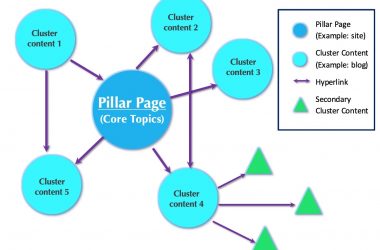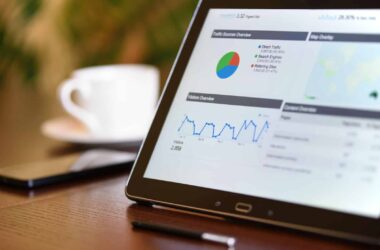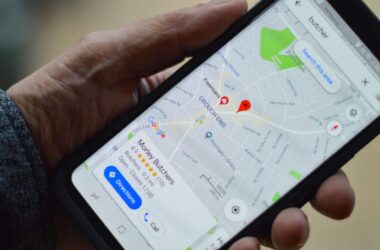Is your business in the renewable energy industry? Are you looking to accommodate your brand position for modern sustainability needs? When it comes to content strategies for your renewable energy marketing needs, we focus on:
- being educational,
- establishing credibility,
- building trust and increasing transparency.
SEO Sydney‘s strategies for the renewable energy industry not only help to build a positive reputation for your business, but can also improve your search result rankings. If your website already has content, re-optimising its position to consider your brand’s values on sustainability also fall into these approaches – the freshness of content is looked upon favourably by Google’s algorithm, in any case.
Ahrefs demonstrates how updating content boosted traffic by 139%, and also gave an example of how refreshing content led to traffic increase by 468%. Branding, as the core consideration for your site output, is important for SEO here, since better brand recognition is often taken as a signal of trustworthiness by search engines – from a user experience perspective, maintaining a ‘green image’ hinges on how your brand stacks in the sustainability market. Updating your position on renewable energy marketing can be incorporated with the content that you produce on your website and social media pages.
Regardless of if your brand is implementing a content strategy from scratch, or if it’s taking its existing stock in a new direction – the below strategies are for you.
Be Educational in Your Renewable Energy Marketing Content
Content that educates existing and potential customers on the importance of switching to greener energy – and its resulting savings experienced to their energy bills – is one of the most effective branding strategies for the renewable energy industry. This is especially valuable information for them to consider when shopping around for renewable energy products. An infographic can be a visual format that your business can use for educating your target audiences about this.
Below is an example of this type of content, depicting major types of renewable sources. In this lane of content, providing infographics or academia with text on your pages can greatly bolster user experience by breaking down complex information into consumable chunks – this then subsequently adds to your SEO signalling as a site providing great, helpful content – increasing its visibility as a valuable search result. Tying services and products that your brand offers into this type of information then augments brand offerings to embellish this feature as a societal benefit or bonus.
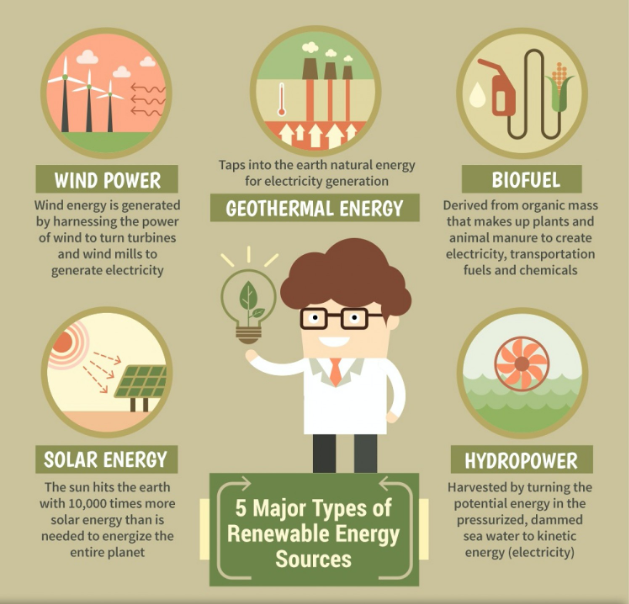
Content used in infographics could be repurposed into longer-form content, such as blog posts, to educate existing and prospective customers about your products. Blog posts, for a property management brand as an example, could be refreshed to discuss how homebuilders and homeowners can benefit from renewable energy, in comparison to the negatives of the non-renewable. Information about the use of renewable energy sources locally, nationally or internationally can also help to educate your customers on the value of switching.
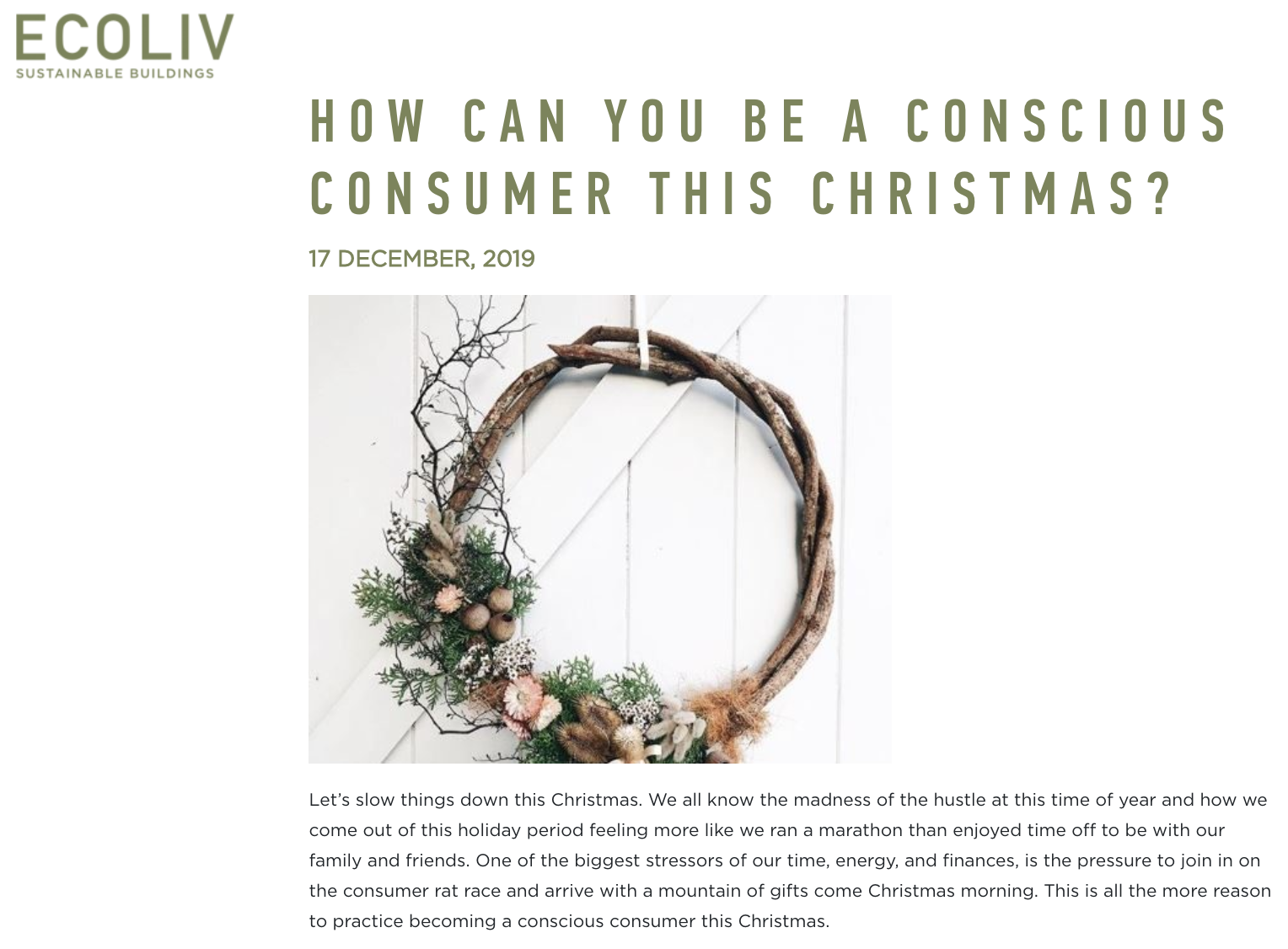
Related to the idea of eco-friendly and sustainable living, one of our clients Ecoliv has a blog post that educates its website viewers about how to incorporate more sustainable purchasing and lifestyle habits during the Christmas season. From the perspective of the brand marketing funnel in renewable energy marketing – this is useful for eco-conscious leads, who may have orbited the brand, but held back on the onus of sustainability values. This scenario is transferable to how your customers are interested in sustainability, and could appreciate seeing a blog post on your site about eco-friendly living. Buy-ins to the brand on this basis could then lead to further browsing for what you offer, tapping into markets curious about sustainability measures that your brand has taken.
Establish Credibility and Presence
Establishing credibility, as a source of reliable information, is significant for a consideration as technical as renewable energy marketing. Using pictures and videos across properties like social media and website makes your offer empirical, and can help not only with SEO signalling, but also for customers to convert between buying from your business or your competitors.
Participate in the Sustainability Conversation
Participating in conversations about green initiatives, the importance of sustainability, and discussions on benefits from helping the environment are examples of how your business can establish a position in the market. Having some form of authority – the likes of an industry expert, or our above examples of valuable data – generates competitive edge to your brand, in contrast to competitors that offer information that is difficult to verify. The tone, style, content and branding on your social media pages should align with that of your website for consistency.
Products that are certified by a reputable third party falls under this umbrella, as a product offering that stands apart from the market for its trustworthy nature.
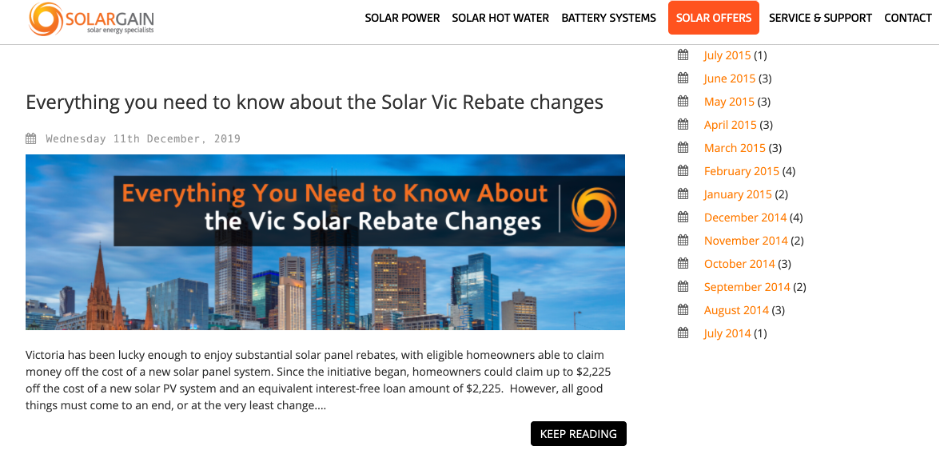
Solargain’s blog, as an example, contains posts about a range of topics related to solar energy, rebates, renewable energy and advances in technology that customers can read and learn more about. Keeping up with the latest technologies and trends in the relevant industry source space is important, too.
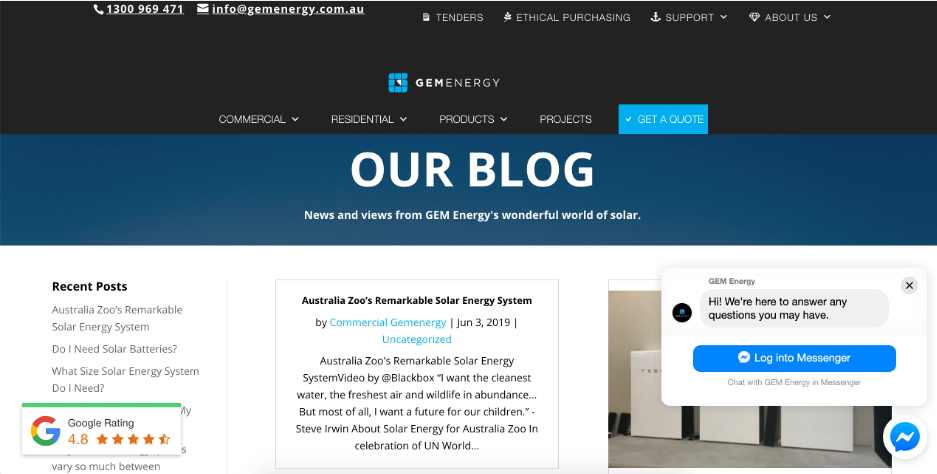
GEM Energy makes itself available on Facebook Messenger to its customers and its pages on various social media platforms such as its Instagram or Twitter, both of which are linked on its website. These social media pages can contain visually appealing images about your business’s awards, projects, products, certifications and more. As shown, your website can be linked in an Instagram post’s caption that customers can go to for more information on your business’s services and products.
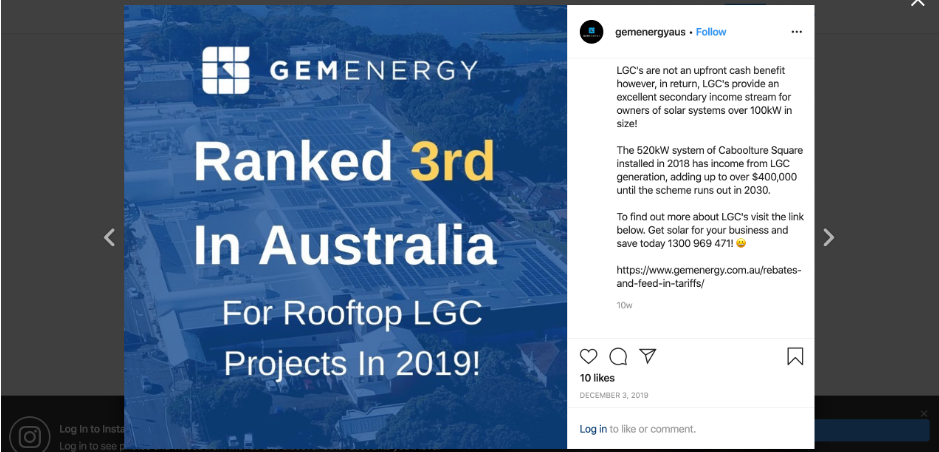
Case Studies
Case studies of how past customers have benefitted from switching to your renewable energy products can also be an effective way of establishing credibility further, alongside showcasing the success that prior customers have had. Using measurable statistics and reputable links to support these case studies helps with credibility, and lends strength to your renewable energy marketing by providing an idea of the significance of investing in your brand.
For example, Leading Edge Energy includes a section on its website specifically for successful case studies, and how much in energy costs that its customers have saved since installing its solar panels.
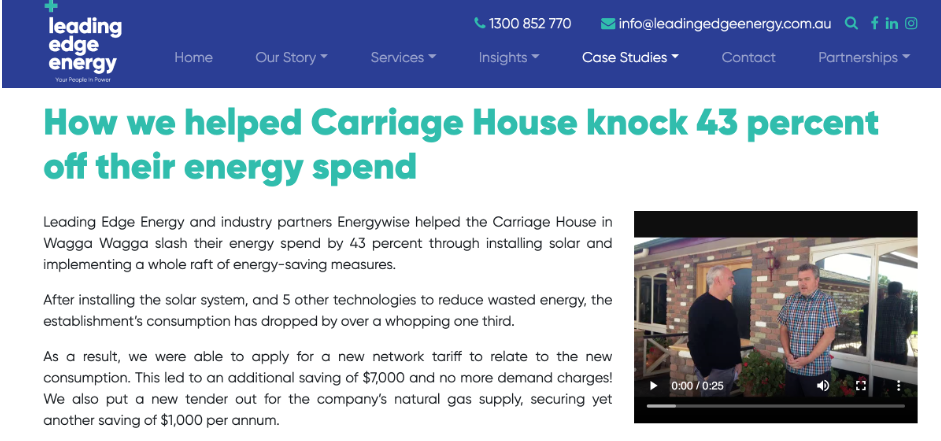
Positive reviews from past customers that have been posted on Google, social media and feedback/satisfaction forms could be included on your website. According to BrightLocal, 82% of consumers read online reviews when searching for local businesses. This signifies the importance of including positive reviews that are easily readable and accessible for prospective customers browsing your websites to view.
Trione Energy is an example of a solar panel business in Melbourne that features its positive Google reviews on its homepage for visitors of the website to easily read, not to mention for Trione Energy to demonstrate its credibility.

Below is an example of a testimonial featured on Champion Energy’s website that can demonstrate to prospective customers how the business has approached new customers in the past, and how they have helped them successfully install their solar systems. Again, the objective is to demonstrate credibility through content, as a means to depict reasons to invest in your brand within green spaces. These testimonials add content to your website, and also helps reassure potential customers about the quality of your service and products.
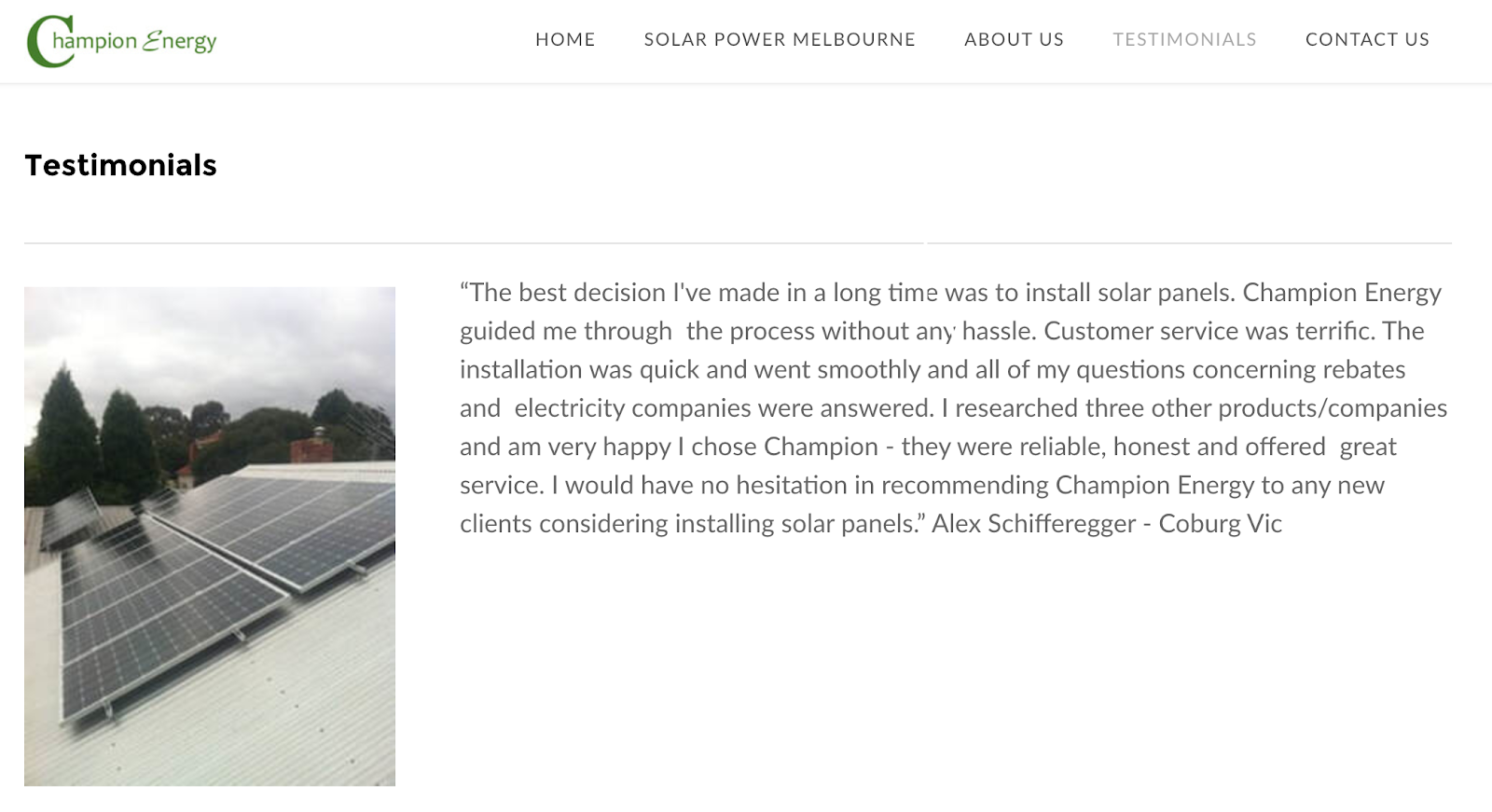
Build Trust and Increase Transparency in Your Renewable Energy Marketing
Building trust and increasing transparency is key in a field where green-washing is rife. Including a Frequently Answered Questions (FAQ) section on your website can be important, to increase the surface area of content able to serve users in an efficient way. It’s an important section of the site that demonstrates care for common concerns, increasing points of contact between brand and user.
What measures are taken to investigate renewable energy, warranties, quality standards and how your business can help are relevant topics to cover on this page. FAQ schemas or structured data can be implemented to display the questions and answers in an optimised, coherent way for search engines to consider. It not only improves your company’s visibility, but also the reach of trustworthiness, if your competitors do not have similar markups.
Using Content to Build Trust
To build trust, creating relevant and high-quality videos is a great approach to renewable energy marketing. Introducing employees who help to operate your wind farms or who help install your solar panels through engaging videos can help you connect with your customers. Including transcripts and descriptions with videos are also ways of making these videos accessible, searchable and helpful for your SEO purposes.
These videos can also be used to tell your business’s story as another way of differentiating your business from your competitors. It is important to include a call to action at the end of these videos, or all pieces of content so that afterwards your audience would be guided as to what it should do.
For example, SunrunSolar’s video on its homepage helps the company connect with its customer by identifying itself as a renewable energy industry leader. Understanding what your customer needs when interacting with you for the first time, and answering these problems through videos can be used as part of your renewable energy marketing strategy.
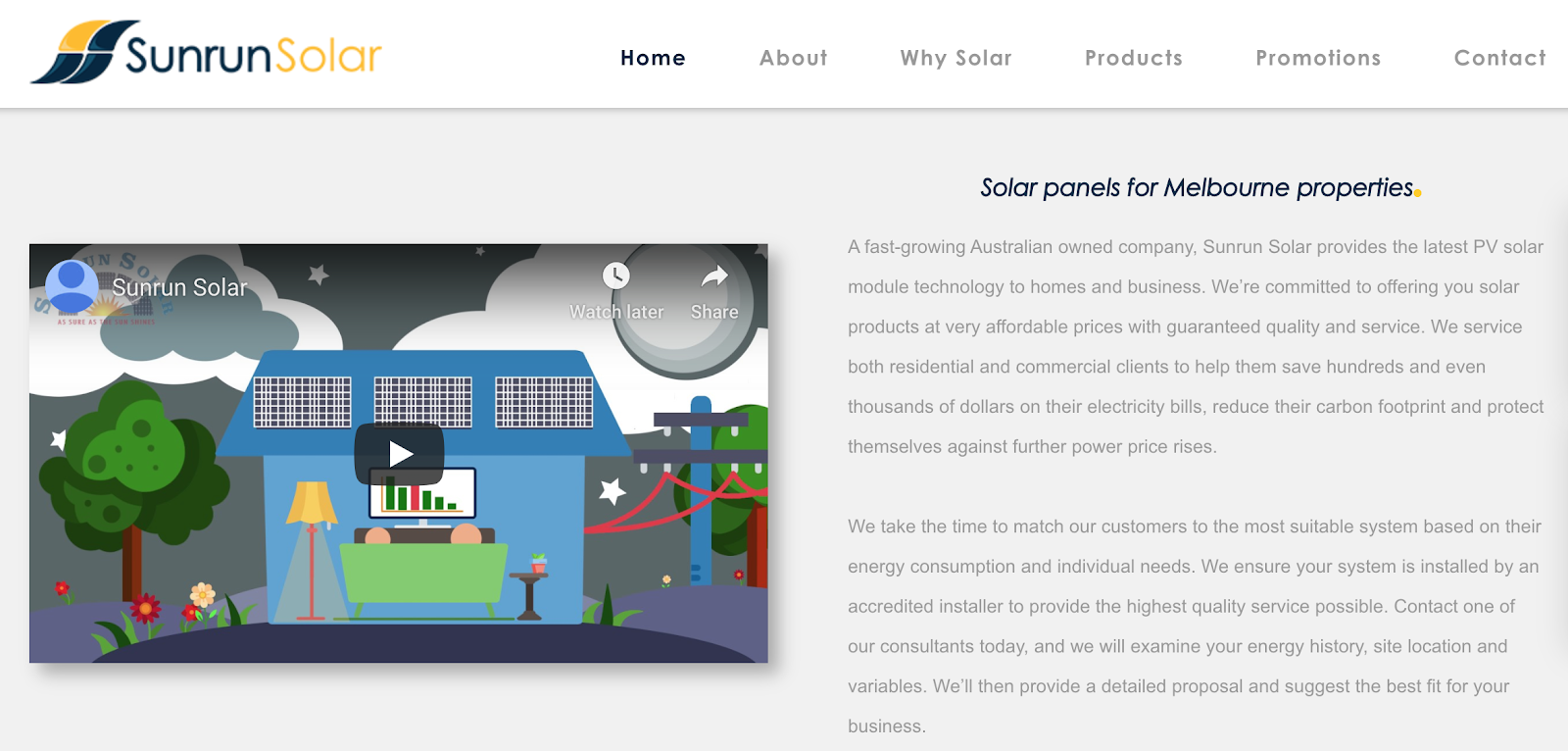
The images you use can be original photos taken of products you offer, or photos taken by customers of their newly installed products. An example below is shown of GEM Energy’s new solar panels, installed for customers by its provider. The brand compiles these case studies in an entire web page to feature pictures of past installations done for customers from a range of industries. With the use of projects done on established businesses such as Bridge Toyota and the Friendly Society Private Hospital, your customers will be more likely to choose your business over a competitor.
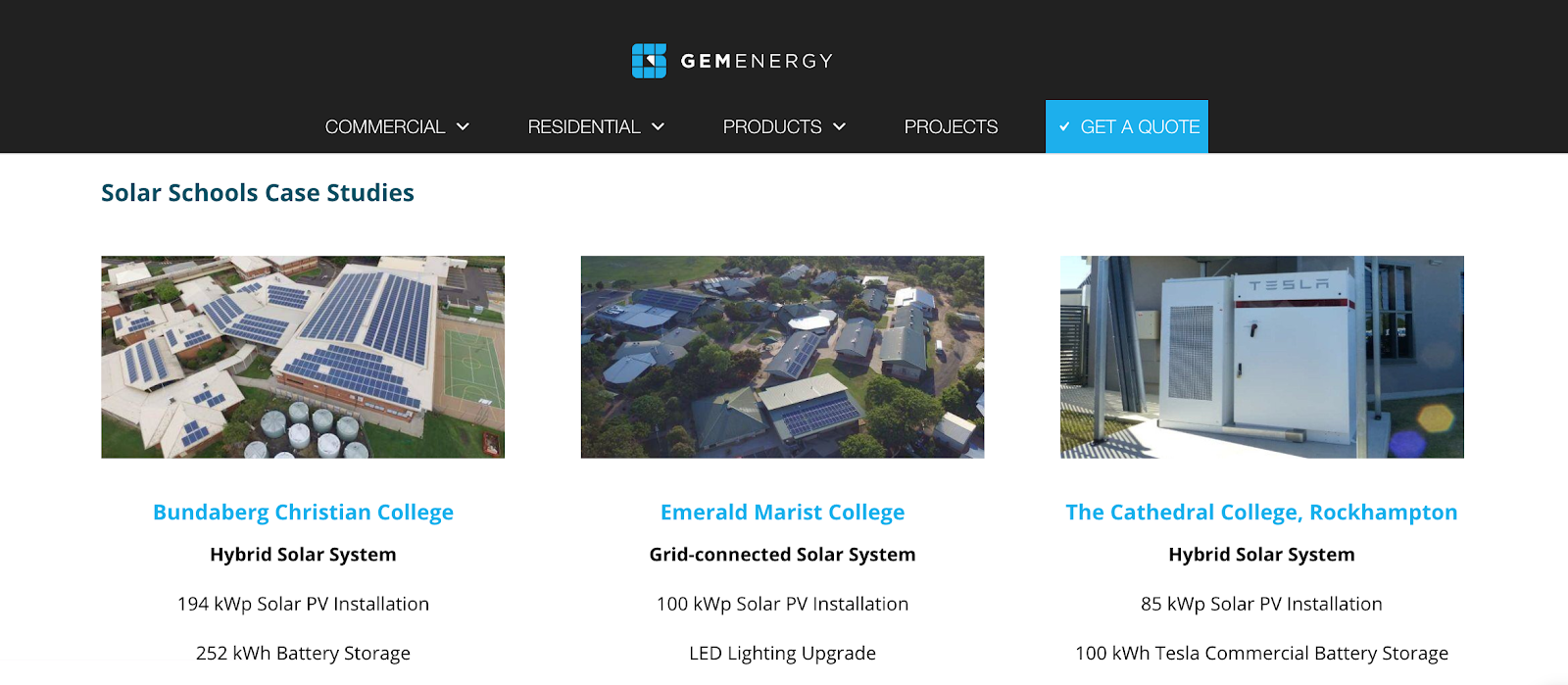
The other benefit of doing this is that if the website viewer is a prospective customer has similar needs to your past customers, then the solar panel system details for past projects may be useful and relevant for them. There are also free images available for use as headers and pictures to accompany descriptions of your products and services from sites such as Unsplash.
Key Takeaways – Renewable Energy Marketing
Using content such as infographics, photos, reviews, testimonials, videos and blog posts is useful as part of your marketing strategies to build trust, increase transparency, establish credibility and be educational. These are the best kinds of content strategies for the renewable energy industry for building awareness towards your business, standing out from other renewable energy businesses and building a positive reputation for your business. Refreshing old content and creating content that is relevant for prospective and existing customers will also help with your business’s SEO.
Also, positioning your company’s offerings with the idea of sustainable living through, for example, social media or blog posts is a way of creating content that aligns with your customers’ core need of saving money on energy costs and being eco-conscious. These content strategies for the renewable industry provide ideas for your content to focus on and to ensure your content is valuable for customers in an educational and informative way.
For more tips related to SEO and digital marketing, check out SEO Sydney today
